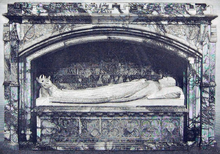John Thynne (clergyman)
Reverend Lord John Thynne ( 7 November 1798 - 9 February 1881 ) was a British Anglican clergyman who was Deputy Dean of Westminster for 45 years .
John Thynne came from the British aristocratic family Thynne . He was the third son of Thomas Thynne, 2nd Marquess of Bath, and Isabella Elizabeth Byng, daughter of George Byng, 4th Viscount Torrington . He attended Eton College and studied at Cambridge , where he graduated with a doctorate in theology . Having already held several parishes, he was 1,828 canons and Deputy Dean of Lincoln Cathedral . He exchanged these offices in 1831 for a canon at Westminster Abbey . In 1835 he became assistant dean of Westminster. In this capacity he took over from 1838 to 1842 and from 1851 to 1856 the duties of the sick deans John Ireland and William Buckland . However, he refused to become Dean of Westminster himself, and he also refused the offices of Deans of Wells or St. George's Chapel at Windsor Castle . Thynne advocated a more correct conduct of services at Westminster Abbey. Several of his sermons have been published.
He lived at Ashburnham House in Westminster . In 1849 he inherited from his childless deceased uncle John Thynne, 3rd Baron Carteret, his lands including the Hawnes Place estate in Haynes , which he had rebuilt.
In 1824 Thynne had married Anna Beresford, a daughter of Reverend Charles Cobbe Beresford. His wife was a zoologist and built the first saltwater aquarium with corals and other marine animals in Westminster in 1846, which she looked after for three years. Thynne had ten children with her, seven of whom reached adulthood, including:
- Francis John Thynne (1830–1910) ∞ Edith Sheridan
- Emily Constantia Thynne (1840-1926)
- ∞ Eustace John Wilson Patten
- ∞ Thomas Taylour, 3rd Marquess of Headfort
- Sir Reginald Thomas Thynne (1843–1926) ∞ Louise Du Bois
He was buried in Haynes, Bedfordshire, and an elaborate marble funerary monument in Westminster Abbey commemorates him.
Fonts
- A sermon preached in the Cathedral Church of St. Paul . Rivington, London 1839
- Sermon preached at Westminster Abbey on March 5, 1876 . Macmillan and Co, London 1876
Web links
- Reverend Lord John Thynne on thepeerage.com , accessed September 25, 2015.
- Westminster Abbey: Lord John Thynne & family
Individual evidence
- ^ History of Parliament Online: THYNNE, Lord John (1772-1849), of 15 Hill Street, Berkeley Square, Mdx. Retrieved September 28, 2015 .
- ^ British Listed Buildings: Clarendon School, Haynes. Retrieved September 28, 2015 .
- ^ Rebecca Stott : Theaters of glass. The woman who brought the sea to the city. Short Books, London 2003. ISBN 1-904095-36-4
| personal data | |
|---|---|
| SURNAME | Thynne, John |
| ALTERNATIVE NAMES | Thynne, Lord John; Thynne, Reverend John |
| BRIEF DESCRIPTION | British clergyman |
| DATE OF BIRTH | November 7, 1798 |
| DATE OF DEATH | February 9, 1881 |

